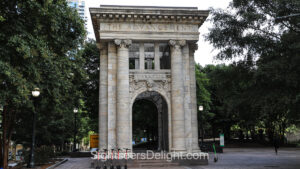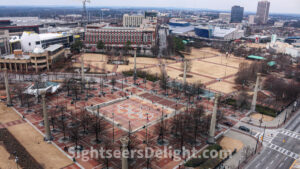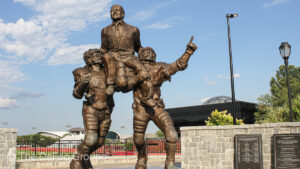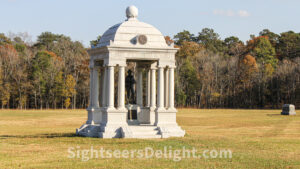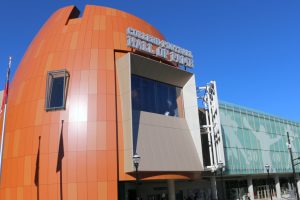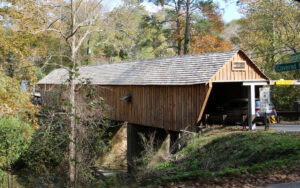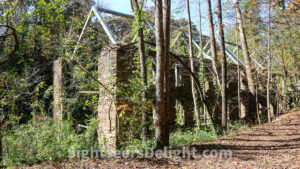The Carnegie Education Pavilion, often called the Carnegie Monument, is a marble Beaux-Arts monument built in 1996 using the exterior facade of the Carnegie Library. From 1899 to 1901, steel magnate Andrew Carnegie donated $145,000 to build and supply a new public library in Atlanta at 126 Carnegie Way. New York architects Ackerman and Ross built the library, which opened in 1902. It was renovated in 1950 and 1966. The central library remained until it was demolished in 1977 to make way for the Marcel Breuer-designed Central Library.
30308
The Casimir Pulaski Monument stands in Monterey Square near the battlefield where Polish nobleman Casimir Pulaski died during the siege of Savannah. Pulaski, along with Michael Kovats de Fabriczy, is considered “the father of the American cavalry.” Workers laid the cornerstone for the monument in either 1825 or 1853, depending on the source. The monument’s inscription reads, “Pulaski, the Heroic Pole, who fell mortally wounded, fighting for American Liberty at the siege of Savannah, October 9, 1779.” On October 29, 1779, Congress passed a resolution that a monument should be dedicated to Pulaski, and the Savannah monument was the first monument in the United States dedicated to Pulaski.
The 21-acre park, today a centerpiece of downtown Atlanta’s tourist district, was built as a central green space and remains a popular place for outdoor events. The park, which helped positively transform downtown Atlanta, is surrounded by some of the city’s biggest tourist destinations, including the Georgia Aquarium and CNN Center.
30313
In November 2008, Athens dedicated “The Character of a Champion,” a 14-foot-tall bronze statue of Vince Dooley, the legendary former football coach of the Georgia Bulldogs. Athens sculptor Stan Mullins crafted the statue of Dooley, depicting the former coach being hoisted onto the shoulders of his players after winning the 1980 national championship. Dooley was head coach from 1964 until 1988. He was the university’s athletic director from 1979 to 2004 and was inducted into the College Football Hall of Fame in 1994. The memorial was dedicated in 2008 before the annual Georgia-Georgia Tech football game.
30605
Designated as a unit of the National Park System in 1978, the Chattahoochee River National Recreation Area preserves and protects the natural and cultural resources of the 48-mile Chattahoochee River corridor from Buford Dam to Peachtree Creek. The park annually welcomes more than 3,000,000 visitors.
Chickamauga and Chattanooga National Military Park preserves the sites of two major battles of the American Civil War: the Battle of Chickamauga and the Chattanooga Campaign.
30742
Opened in 1965, the Clermont Lounge has the distinction as the first and longest continually operating strip club in Atlanta. The establishment is located in the basement of what was once the Clermont Motor Hotel. As Wikipedia notes: “The Clermont is perhaps best known for featuring some dancers who do not meet the traditional physical standards for strippers, the most famous of whom is Blondie, noted for her ability to crush empty beer cans between her breasts as well as for her poetry.”
The College Football Hall of Fame opened in Atlanta in August 2014 in Downtown Atlanta next to the Georgia World Congress Center and Centennial Olympic Park. The College Football Hall of Fame was previously located in South Bend, Ind. More than 975 players and more than 210 coaches have been enshrined in the College Football Hall of Fame. More than 300 schools are represented. The 94,256-square-foot facility includes exhibits, interactive displays, event space and a 45-yard indoor football field.
30313
The Concord Covered Bridge over Nickajack Creek was built in 1872 to replace an earlier bridge destroyed during the Civil War. The one-lane bridge, also known as Nickajack Creek Covered Bridge, is more than 130 feet long and 16 feet wide and is a part of the Covered Bridge Historic District, so named for the bridge. An earlier bridge was built in the area in 1848, but troops under Union Gen. William T. Sherman burned the span on July 4, 1864. The current bridge was renovated or upgraded in the 1950s and again in 1999. Much of the traffic that used to cross the bridge was diverted to the East-West Connector when it opened in the 1990s. The one-lane bridge has a relatively low clearance, and several times every year motorists driving vehicles too big for the bridge crash into the structure and damage it.
30082
Concord Woolen Mills dates to 1847 when Robert Daniell and Martin Ruff opened the mill. The mill was destroyed on July 4, 1864, by Union Gen. William T. Sherman’s troops. The two men rebuilt the mill, which reopened in 1868. By 1870, the mill had 16 workers, making it the largest employer in the area. The two men sold the mill in 1872. The mill went out of business in 1916, and the ruins are located along what is today the Heritage Park Trail and Silver Comet Trail.
30082

